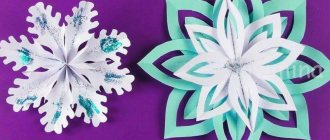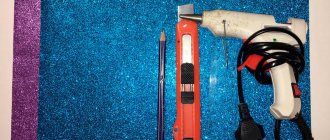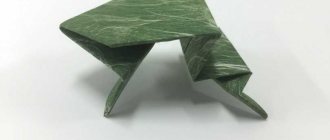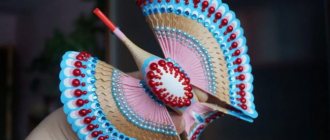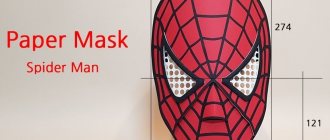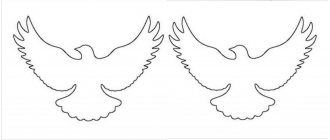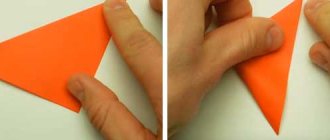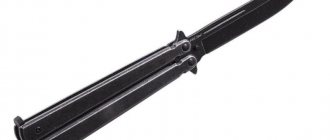How to make three-dimensional geometric shapes from paper (diagrams, templates)?
Here are several schemes by which you can make three-dimensional geometric shapes.
The simplest one is a tetrahedron .
It will be a little more difficult to make an octahedron .
But this three-dimensional figure is a dodecahedron .
Another one is the icosahedron .
More details about making three-dimensional figures can be found here.
This is what three-dimensional figures look like when not assembled:
And this is what the finished ones look like:
You can make many original crafts from volumetric geometric shapes, including gift wrapping.
So that children can better remember what geometric shapes are and know what they are called, you can make three-dimensional geometric shapes . By the way, you can use them to make beautiful gift wrapping.
- thick paper or cardboard (preferably colored);
- ruler;
- pencil;
- scissors;
- glue (preferably PVA).
The most difficult thing is to develop and draw developments; you need at least basic knowledge of drawing. You can take ready-made scans and print them on a printer.
To keep the fold line straight and sharp, you can use a blunt needle and a metal ruler. When drawing a line, the needle must be bent strongly in the direction of movement, almost laying it on its side.
This is a development of a trihedral pyramid
This is a cube scan
This is the development of an octahedron (tetrahedral pyramid)
This is the development of a dodecahedron
This is the development of an icosahedron
Here you can find templates for more complex figures (Platonic Solids, Archimedean Solids, polyhedra, polyhedra, different types of pyramids and prisms, simple and oblique paper models).
By the way, to calculate the parameters of the pyramid, you can use this program.
By making three-dimensional figures from paper yourself, you can not only use them for entertainment, but also for learning.
For example, you can clearly show your child what a particular figure looks like and let him hold it in his hands.
Or you can print out diagrams with special symbols for training purposes.
So I suggest below that you familiarize yourself with the dodecahedron , both simple and with small drawings that will only attract the baby’s attention and make learning more fun and entertaining.
cube diagram can also be used to teach numbers.
pyramid diagram can help you learn the formulas that apply to a given figure.
In addition, I suggest you familiarize yourself with the diagram of the octahedron .
tetrahedron diagram will also help you learn colors.
As you understand, the above templates must be printed, cut out, bent along the lines, and glued along special narrow strips adjacent to selected sides.
Before you start making three-dimensional geometric shapes, you need to imagine (or know what it looks like) the figure in 3D dimension: how many faces does this or that figure have.
First you need to correctly draw a figure on paper along the edges that must be connected to each other. Each shape has edges that have a specific shape: square, triangle, rectangle, rhombus, hexagon, circle, etc.
It is very important that the length of the edges of the figure that will be connected to each other are the same length, so that no problems arise during the connection. If the figure consists of identical faces, I would suggest making a template while drawing and using this template. You can also download ready-made templates from the Internet, print them, bend them along the lines and connect (glue) them together.
Step-by-step instructions for writing the “Treasured Triangle” letter
This technique can be used by: kindergarten teachers, teachers and parents. Triangles can be given to a veteran. It will serve as an exhibit at a crafts exhibition or be part of a military-themed wall newspaper.
By creating a greeting card, the younger generation gains skills in handling paper, scissors and glue. Children develop creativity and imagination. In addition, perseverance is acquired and a sense of patriotism is cultivated.
Materials
It is necessary to prepare in advance:
- Multi-colored sheets of paper.
- Scissors.
- Glue.
- St. George's ribbon.
- Plasticine.
- A tea bag or instant coffee.
Staying safe with scissors
- Never leave them open.
- Transfer only rings forward.
- Do not play under any circumstances.
- Use only as needed.
Rules for working with PVA glue
- Use a brush.
- Avoid collecting excess; what is unnecessary is removed with a paper napkin.
- Apply carefully in a thin layer.
- Avoid contact with clothing, face and eyes.
- Upon completion of the action, the tube is tightly closed and stored in a secluded place.
- Hands and the area where they worked are washed with soap.
When designing, for greater believability, they resort to different shades and “relief” in order to “age” the paper. The words that the author chose as a congratulation are printed out and blotted with a sponge on both sides. Next, coffee is sprinkled over the entire surface of the sheet, the grains of which are dissolved with a moistened piece of foam rubber. The sheet is left to dry.
To add a solemn moment to the message to dear participants of military events in the form of a triangle, it is not forbidden to decorate it by making a composition of the corresponding attributes. A certain length is measured from the St. George ribbon, then it is applied to the corner of the paper in the shape of a triangle, cut and glued. Daisies are cut out of white paper, the edges of which are folded with a pencil.
Leaves are formed from green paper with scissors. The stems are placed on the St. George ribbon, flowers and leaves are glued. The middle parts are decorated with yellow plasticine, which must be rolled into balls. To make them look impressive, they need to be pressed down a little.
As a complement, an inscription is included, similarly processed with a brewed tea bag. Soldiers always looked forward to such “triangles” as if they were cherished news from home, and then re-read them many times.
Pyramid - development. Pyramid development for gluing. Paper scans
Rectangle, square, triangle, trapezoid and others are geometric figures from the section of exact science. A pyramid is a polyhedron. The base of this figure is a polygon, and the side faces are triangles with a common vertex, or trapezoids. To fully represent and study any geometric object, mock-ups are made. They use a wide variety of materials from which the pyramid is made. The surface of a polyhedral figure, unfolded on a plane, is called its development. The method of converting flat objects into three-dimensional polyhedra and certain knowledge of geometry will help you create a layout. It is not easy to make developments from paper or cardboard. You will need the ability to make drawings to specified dimensions.
Modeling various polyhedra
To learn how to make more complex models, it is worth starting with the basics, for example, with 3D triangles. Gradually improving your skill in creating simple layouts, you can begin to create complex models. Complex figures require skills and refined dexterity when performing, for example, at the time of unfolding or shaping the figure, you need to act so that it does not accidentally break.
When making a drawing, you should carefully apply markings and be able to draw shapes.
If you have a question about how to make a high-quality paper pyramid, there is a detailed diagram with individual dimensions. You just have to put in a little effort, and then it will be difficult to do beautiful and high-quality work that will please the eye.
Thanks to the above methods, you can easily create various pyramid layouts. It is not difficult to learn how to perform these techniques, the main thing is to follow all the steps gradually and carefully.
Defining parameters
First of all, let's determine what the pyramid will be like. The development of this figure is the basis for making a three-dimensional figure. Completing the work will require extreme precision. If the drawing is incorrect, it will be impossible to assemble a geometric figure. Let's say you need to make a model of a regular triangular pyramid.
Any geometric body has certain properties. This figure has a regular polygon as its base, and its vertex is projected into its center. An equilateral triangle was chosen as the base. This condition determines the name. The side edges of the pyramid are triangles, the number of which depends on the polyhedron chosen for the base. In this case there will be three of them. It is also important to know the dimensions of all the components that will make up the pyramid. Paper developments are made in accordance with all the data of the geometric figure. The parameters of the future model are agreed upon in advance. The choice of material used depends on these data.
How is a regular pyramid unfolded?
The basis of the model is a sheet of paper or cardboard. Work begins with a drawing of the pyramid. The figure is presented in expanded form. A flat image on paper corresponds to pre-selected dimensions and parameters. A regular pyramid has a regular polygon as its base and its height passes through its center. Let's start by making a simple model. In this case, it is a triangular pyramid. Determine the dimensions of the selected figure.
Modular triangle
Despite the fact that the construction of crafts requires small blanks, to better master the assembly technique, it is preferable to use a wide-format sheet of paper.
When manufacturing the module, the following proportions between the sides must be observed - 1 to 1.5.
Order of steps:
- Fold the sheet in half, press the center line vertically and bend the ends to the middle basting.
- Unfold the workpiece on the other side and lift the edges-ears up;
- Bend the side corners through the main module.
- Straighten the product, fold small triangles along the lines, lift the edges up. Fold the base in half. An element with two corners and pockets should come out.
If you make a lot of such modules, then you can assemble quite interesting things from them, for example, a fairy-tale dragon.
Development of a quadrangular pyramid
First, let's imagine what the geometric figure looks like, the model of which we will make. The base of the selected pyramid is a quadrangle. The side ribs are triangles. For work we use the same materials and devices as in the previous version. We draw the drawing on paper with a pencil. In the center of the sheet we draw a quadrilateral with the selected parameters.
We divide each side of the base in half. We draw a perpendicular, which will be the height of the triangular face. Using a compass solution equal to the length of the side face of the pyramid, we make notches on the perpendiculars, placing its leg at the top of the base. We connect both corners of one side of the base to the resulting point on the perpendicular. As a result, we get a square in the center of the drawing, on the edges of which triangles are drawn. To fix the model on the side faces, add auxiliary valves. For reliable fastening, a strip of centimeter width is enough. The pyramid is ready for assembly.
What you need to make a tetrahedron with your own hands
List of materials and tools required to create a paper or cardboard tetrahedron:
- thin cardboard;
- paper or hard cardboard;
- a simple pencil;
- ruler;
- protractor;
- scissors, stationery knife;
- glue pencil or Moment glue.
It is desirable that the paper on which the drawing will be constructed be thick. Drawing sheets, watercolor paper, or scrapbook paper will work. You can use printer paper with a weight of at least 80 gsm. m. Thinner material will not hold its shape well, and will also tear and wrinkle during the process of gluing the figure.
Construction of a drawing
The development of a truncated pyramid is performed in several stages. The side face of a truncated pyramid is a trapezoid, and the bases are similar polyhedra. Let's say these are squares. On a sheet of paper we draw a trapezoid with the given dimensions. We extend the sides of the resulting figure until they intersect. The result is an isosceles triangle. We measure its side with a compass. On a separate sheet of paper we construct a circle, the radius of which will be the measured distance.
The next stage is the construction of the side ribs that the truncated pyramid has. The sweep is performed inside the drawn circle. Using a compass, measure the lower base of the trapezoid. On the circle we mark five points that connect the lines to its center. We get four isosceles triangles. Using a compass, measure the side of the trapezoid drawn on a separate sheet. We put this distance on each side of the drawn triangles. We connect the resulting points. The side faces of the trapezoid are ready. All that remains is to draw the upper and lower bases of the pyramid. In this case, these are similar polyhedra - squares. We add squares to the upper and lower bases of the first trapezoid. The drawing shows all the parts that the pyramid has. The scan is almost ready. All that remains is to finish drawing the connecting valves on the sides of the smaller square and one of the faces of the trapezoids.
Method 4
Necessary tools for crafts:
- paper sheet,
- triangle,
- scissors,
- pencil,
- glue,
- eraser.
Performance:
- Cut out a square. Bend the workpiece in half in different directions to form folds.
- Place the diagonal of the triangle on each side of the square and make marks along the folds.
- Using lines, connect the triangle with the vertices. For accuracy, it is recommended to use a ruler.
- Mark the gluing lines of the sides with a pencil.
- Cut out the shape and apply glue to the gluing lines.
Development of geometric shapes
Large selection of developments of simple geometric shapes.
Children's first introduction to paper modeling always begins with simple geometric shapes such as cubes and pyramids. Not many people succeed in gluing a cube together the first time; sometimes it takes several days to make a truly even and flawless cube. More complex figures, a cylinder and a cone, require several times more effort than a simple cube. If you don’t know how to carefully glue geometric shapes, then it’s too early for you to take on complex models. Do it yourself and teach your children how to do these “basics” of modeling using ready-made patterns.
To begin with, I, of course, suggest learning how to glue a regular cube. The developments are made for two cubes, large and small. A small cube is a more complex figure because it is more difficult to glue than a large one.
So, let's begin! Download the developments of all the figures on five sheets and print them on thick paper. Before printing and gluing geometric shapes, be sure to read the article on how to choose paper and how to properly cut, bend and glue paper.
For better quality printing, I advise you to use the AutoCAD program, and I give you patterns for this program, and also read how to print from AutoCAD. Cut out the development of the cubes from the first sheet, be sure to draw a compass needle under the iron ruler along the fold lines so that the paper bends well. Now you can start gluing the cubes.
To save paper and just in case, I made several unfolds of a small cube, you never want to glue more than one cube together or something won’t work out the first time. Another simple figure is a pyramid, its development can be found on the second sheet. The ancient Egyptians built similar pyramids, although not made of paper and not so small in size
